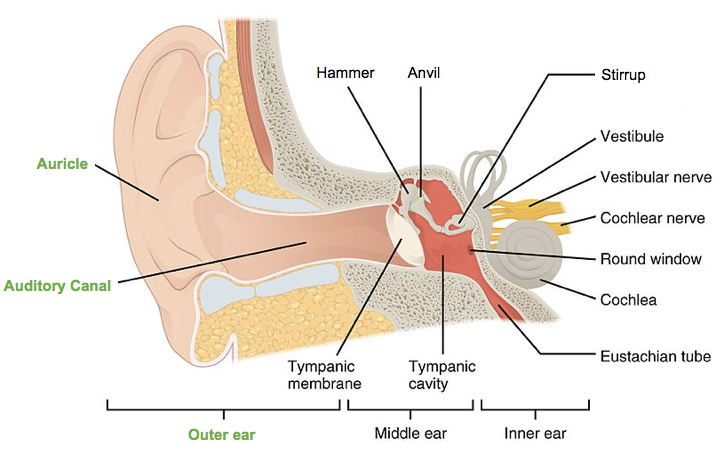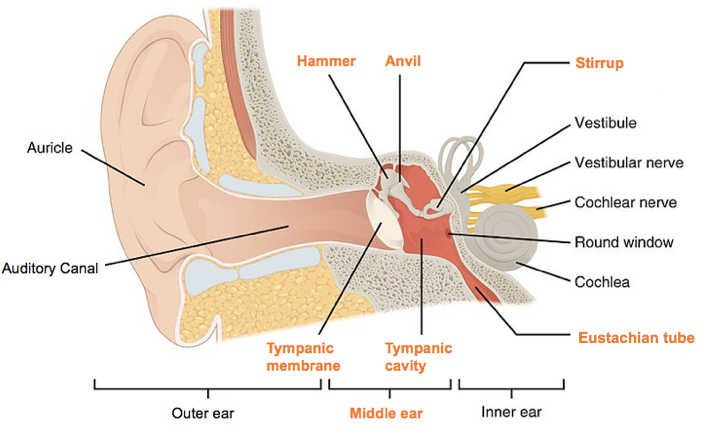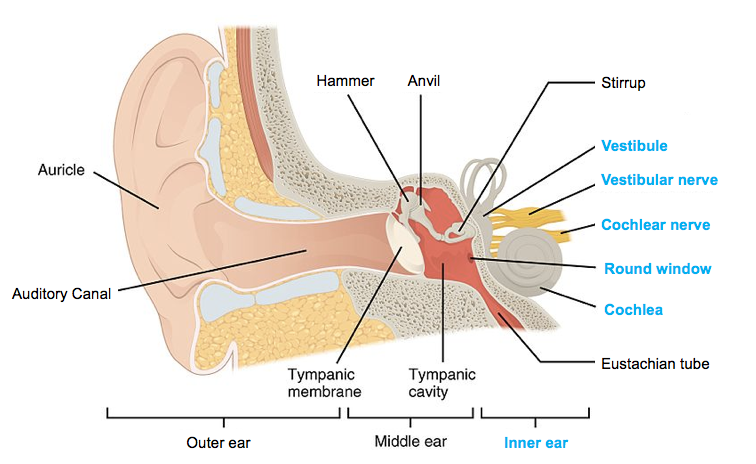Welcome to this lesson on ear anatomy. Today you will be learning about the structure and function of the ear. Specifically, you will look at:
1. Outer Ear
The function of the ear is to be able to detect sound, which travels as a wave and is measured in decibels. Your ear has several structures within it that can detect sound waves and then interpret them.
The first main area of your ear is called the outer ear which is composed of the part of your ear that you can see from the outside as well as the auditory canal. The auditory canal’s purpose is to direct sound waves inward, toward the organs and receptors of hearing.

-
-
- Sound
- Mechanical energy that travels in the form of a wave detected by our ears.
- Decibel
- A unit of measurement which indicates the loudness of a sound.
- Outer Ear
- Anatomically, the outer part of the ear traps and funnels compressed air inward toward the middle ear; anatomic structures included are the auricle/pinna, auditory canal.
- Auditory Canal
- Otherwise known as the ear canal and a part of the outer ear; the auditory canal guides sound waves toward the tympanic membrane.
2. Middle Ear
The tympanic membrane (aka the "eardrum") is where the auditory canal of the outer ear ends and the middle ear begins. When a sound wave enters the ear through the auditory canal, it will strike the tympanic membrane, causing the tympanic membrane to vibrate. This causes three small bones called auditory ossicles to vibrate, which plays a crucial role in hearing. These three bones often are nicknamed the hammer, anvil, and footplate or stirrup based on their shapes.

-
-
- Tympanic Membrane
- A thin, highly innervated tissue at the end of the auditory canal that is attached to the auditory ossicles. When sound waves strike the tympanic membrane, it vibrates, which causes the auditory ossicles to shift and press against the cochlea, commonly referred to as the "eardrum."
- Middle Ear
- The middle portion of the ear that is primarily designed to mechanically amplify the sound waves that enter the ear; anatomic structures included are the tympanic membrane (eardrum), auditory ossicles (malleus, incus, stapes) and the eustachian tube.
3. Inner Ear
The inner ear has two functions:
- To convert the mechanical vibrations of sound into electrical impulses that can be sent along neurons to the brain
- Detect body position/equilibrium.
The following is a diagram showing the structures of the inner ear.

-
-
- Inner Ear
- The inner portion of the ear deeply embedded within the temporal bone; contains the organs of hearing and balance/equilibrium; organs within the inner ear are the cochlea, the vestibular system, Organ of Corti, tectorial membrane, hair cells (stereocilia), round window, otolith organs, auditory nerve, and the semicircular canals.
3a. Cochlea
The cochlea is a structure in the inner ear that is responsible for hearing. Within the cochlea, the Organ of Corti, tectorial membrane, and round window are structures that perform the function of converting sound to nerve impulses.

The Organ of Corti has little hair cells, which are mechanoreceptors, and they push against the tectorial membrane, which helps to detect the intensity of a sound. This tectorial membrane is a jelly-like structure and very pliable.
Once hair cells get pushed against the tectorial membrane, a neurotransmitter will be released, which will then trigger an action potential in the neurons of the auditory nerve. The auditory nerve will then carry those signals to the brain for interpretation.
The round window acts as a pressure release valve if too much pressure builds up in the ear.
-
-
- Cochlea
- The organ of hearing found within the inner ear; contains the sensory receptors for hearing (hair cells/stereocilia), Organ of Corti, tectorial membrane, round window, and the auditory nerve.
- Organ of Corti
- A highly specialized organ found within the cochlea that contains the hair cells/stereocilia and their supporting structures (tectorial membrane, basilar membrane).
- Hair Cells
- The mechanoreceptors for hearing within the cochlea; the hair cells bend due to mechanical fluid vibrations within the cochlea; the bending of the hair cells causes them to depolarize and generate action potentials; the hair cells are also called stereocilia.
- Tectorial Membrane
- One of two gel membranes located within the cochlea of the ear and is part of the Organ of Corti; the two gel membranes contribute to the mechanical process of hearing.
- Auditory Nerve
- The nerve that projects auditory information detected by the hair cells in the cochlea to the primary auditory cortex of the temporal lobe.
- Round Window
- A structure in the cochlea that acts to dampen the mechanical fluid vibrations within the cochlea to prevent damage to the hair cells.
3b. Vestibular Apparatus
Above your auditory nerve, you have the vestibular apparatus, which detects position and equilibrium via the semicircular canals and the otolith organs.

There are three semicircular canals. Each canal detects certain movements.
- One for detecting your position up-and-down
- One for detecting your position backward-and-forward
- One for detecting your position right-and-left
Otoliths are bits of calcium carbonate within the fluid-filled sacs that move as the head's position in space changes and found in the saccule and utricle of the inner ear. These two structures make up the
otolith organs.
-
EXAMPLE
If you were to turn your head to the side, the otolith organs shift to the side as well, allowing the head's movement and position in space to be detected.
-
-
- Vestibular Apparatus
- A system within the inner ear that provides us with feedback about our body position and balance; consists of the semicircular canals and the otolith organs.
- Semicircular Canals
- A system of canals in the vestibular system of the inner ear that provide feedback about body position.
- Otolith Organs
- The saccule and utricle, each with an otolith (hard bits of calcium carbonate).
4. Hearing Overview
-
-
Sound waves reach the outer ear.
The mechanical pressure of sound waves is funneled through the outer ear's auditory canal.
-
The mechanical pressure is transferred through the middle ear.
When the sound waves reach the tympanic membrane (eardrum), the tympanic membrane vibrates. The vibration is transferred via three small bones called ossicles to the inner ear.
-
Mechanoreceptors in the inner ear convert pressure produced by sound waves into electrical impulses that are sent to the brain.
The ossicles of the middle ear vibrate mechanoreceptors called hair cells within the cochlea. When these hair cells vibrate in response to sound waves, they put pressure on the tectorial membrane, which causes the release of neurotransmitters that spur an action potential along the auditory nerve. Thus, an electrical signal is sent from the ear to the brain.
-

Investigate the anatomy of the ear and the components your auditory system in three dimensions using augmented reality (AR)!
If you’re on a laptop or desktop computer:
Scan the QR code using the camera on your smartphone or tablet.
If you are on a phone or tablet
click here.
So, this lesson has been an overview of anatomy of the ear. Specifically, you learned about the function and structure of the ear, specifically looking at the outer, middle, and inner ear.
Keep up the learning and have a great day!





 Investigate the anatomy of the ear and the components your auditory system in three dimensions using augmented reality (AR)!
Investigate the anatomy of the ear and the components your auditory system in three dimensions using augmented reality (AR)!